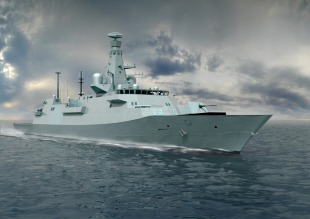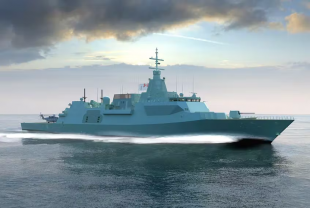Single Class Surface Combatant Project
Basic information
The Single Class Surface Combatant Project is a naval procurement program for the Royal Canadian Navy created to replace the aging Iroquois-class anti-air warfare destroyers and Halifax-class multi-role frigates. The Iroquois and Halifax ships have come to the end or are nearing the end of their service lives and require replacement. The Iroquois class was originally scheduled for retirement around 2010 after 40 years in service; the ships were then expected to have their service lives extended until replacements were commissioned. However, all four have been decommissioned, the last being HMCS Athabaskan in March 2017. The Halifax class is projected to end their service lives in the 2020s.
The navy had investigated adopting the active phased array radar (APAR), leading observers to suggest that APAR and the associated SMART-L would equip the Single-Class Surface Combatant or upgraded Halifax-class ships during the Frigate Equipment Life Extension (FELEX) project. Upgrades to the existing Halifax class with such a system would likely be difficult since the APAR requires its own mast and might make the Halifax-class design top-heavy.
In the 2008 Canadian National Shipbuilding Procurement Strategy, $26 billion was planned for the construction of the 15 vessels of the Single Class Surface Combatant Project. The first ships were slated to become available in 2026. The initial plan called for separate bids for design and integration of systems aboard the vessels. The government later investigated merging those bids.
On 26 October 2012 a letter of interest was published by Public Works and Government Services Canada to announce a session in which interested firms could find out the needs of DND for the new class and the project in general. The closing date was 5 November 2012. On 20 January 2015, Irving Shipbuilding was named the prime contractor for the program. The role of the lead contractor gave Irving Shipbuilding overall control of the project, and the company had already won the right to build the vessels at its yard in Halifax, Nova Scotia. This led to questions concerning the bidding process and the awarding of the contracts. In fall 2015, high increases in costs were reported, more than doubling to $30 billion from $14 billion for the new warships. The total cost of the naval ship building program rose from $26.2 billion to $42 billion in a study. This put in jeopardy the number of ships that could be produced and raised the prospect of ships with reduced capabilities.
In November 2015, seven companies were pre-qualified for the combat systems integrator role. Atlas Elektronik, DCNS, Lockheed Martin Canada, Saab Australia, Selex ES, Thales Nederland and ThyssenKrupp Marine Systems Canada all made the shortlist. For the warship designer role, the following companies were pre-qualified: Alion-JJMA, BAE Systems, DCNS, Fincantieri, Navantia, Odense Maritime Technology and ThyssenKrupp Marine Systems Canada.
On 13 June 2016, Minister of Public Services and Procurement Judy Foote announced that the government would buy and modify an off-the-shelf design for the new warships, instead of designing them from scratch. The minister said a competitive bid for an existing design would knock about two years off the process and save money. The nearly $2 billion saving in research and development costs would allow for more ships to be built and the integration of more advanced technology with increased capability, over the long term.
It was originally anticipated that two CSC ship variants would have been acquired to replace the specific capabilities of the Iroquois-class destroyers and Halifax-class frigates. As originally intended, both variants would have the necessary combat capabilities to operate in air, surface and subsurface threat environments. A small number of ships (up to five) would have additionally incorporated the sensors, guided weapons and command and fire control facilities necessary to perform large-area air defence, along with having the facilities to be task force flagships. The remaining ships would have replaced the capabilities provided by the current fleet of Halifax-class frigates as a more general purpose/antisubmarine warfare variant. However, only one variant will be acquired due to cost effectiveness, crew training efficiencies, and being better suited to the navy's operational needs.
On 20 October 2020, Alan Williams (former Assistant Deputy Minister, Supply Operations Service in Public Works and Government Services Canada, and former Assistant Deputy Minister of Materiel at the Department of National Defence) released a paper examining the estimated life-cycle costs of Canada's Canadian Surface Combatants. Williams estimated that acquisition, operating and supporting the Canadian Surface Combatants throughout their life-cycle of approximately 30 years will cost between $213.5 and $219.6 billion. Approximately two-thirds of these costs are attributable to the long-term operations and support (O&S) costs of the CSC.
This report caught the attention of the House of Commons Standing Committee on Government Operations and Estimates. Additionally, the National Shipbuilding Strategy was set to have a planned Auditor General review in early 2021. This level of watchdog review and spiralling cost estimates drew parallels to Canada's acquisition of F-35 Lightning II fighter jets.
Australia
In June 2018, the Australian Government announced that it had selected a modified version of the Type 26 platform as the planned replacement for its Anzac-class frigate. This will see the Royal Australian Navy procure up to nine Hunter-class frigates, which will be constructed by BAE Systems Australia at ASC's shipyard in Osborne, South Australia.
Canada
On 8 February 2019, Procurement Minister Carla Qualtrough announced that the Canadian government had awarded Lockheed Martin Canada a C$185 million contract to design a fleet of up to 15 warships based on the Type 26 (the Canadian Surface Combatant), with a total program cost of $60 billion. The amount of the contract will increase as the design work increases. The initial design contract is with Irving Shipbuilding of Halifax.
- Comments
 en
en ru
ru uk
uk



 Royal Canadian Navy
Royal Canadian Navy Royal Australian Navy
Royal Australian Navy Royal Navy
Royal Navy